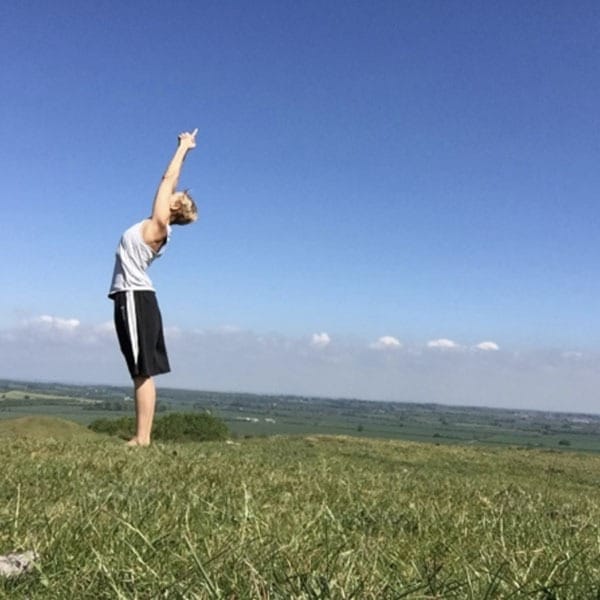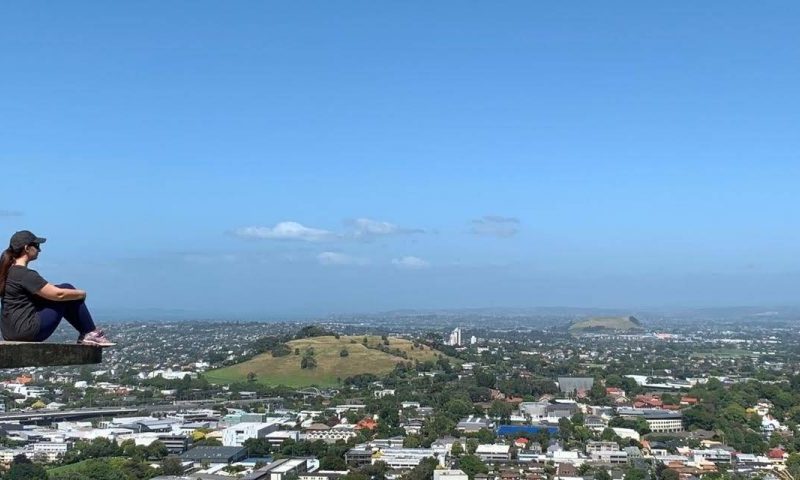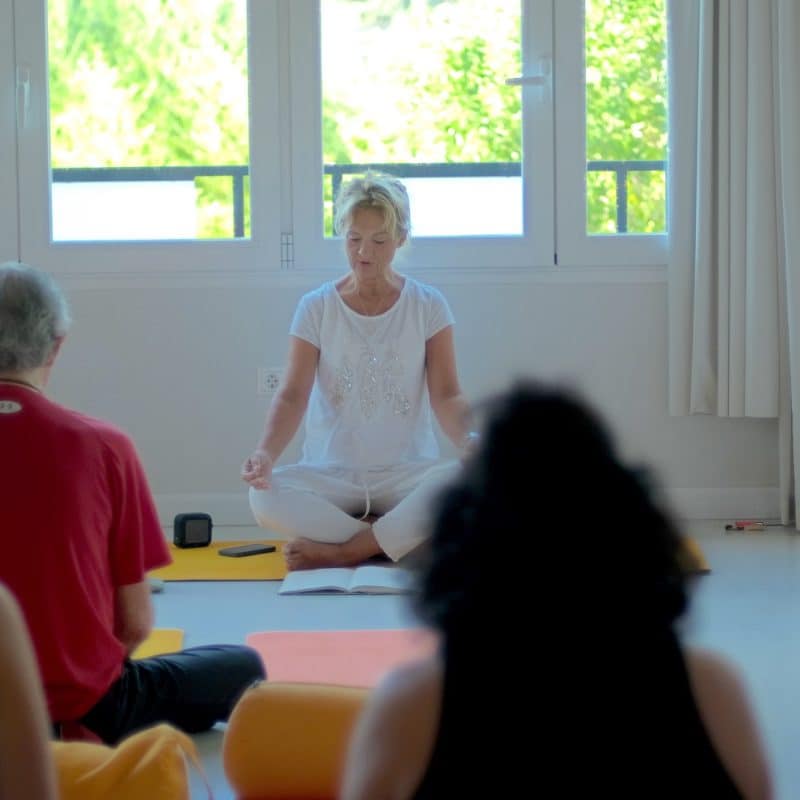When asked what makes us happy, most people answer, ‘finding peace of mind’
What do we mean by ‘peace of mind’?
Everything on the earth
in between, and above
Is arising from one effulgent source
If my thoughts,words and deeds
reflected this complete understanding of unity,
I would be the peace I am seeking in this moment.Gayatri Mantra ( translations supplied by Donna Farhi)
What do we mean when we talk about peace of mind? Do you find it easy to calm your thoughts?
The dictionary definition of peace says
‘ the state of not being interrupted, annoyed by worry, problems, worries or unwanted actions’.
It can of course mean many things for different people, but for me, when I think about when I have peace of mind, mostly I experience being in a more ‘flow-state’, a sense of being ‘unruffled’ and this feeling dominating temporary sensations and becoming more constant.
Identify when you last felt peaceful
Can you identify when you last felt peaceful? Think about what were you doing.
In what environment were you? Was the peace momentary or constant?
Perhaps in just doing that exercise of remembering you had to ‘pause’ what you were doing, perhaps you took a deeper breath.. Maybe you really connected to where you were and got a sense of calm again? Was this experience peace of mind?
Inner tranquility is within us, its always there
The ancient Yogis and sages express that there is an inner tranquility within us all the time, therefore we can access this whenever we like. Also when we take our ‘comfortable seat’ in a Yoga Asana ( posture) if we relax into a state of calm and observe the mind from a neutral viewpoint, this can bring us a more peaceful mind. Even at first if we observe a fluctuating mind and recognise busy thoughts, staying aware of our natural rhythms, like the rise and fall of our breath can deliver us a certain amount of peace. If we are able to detach from the thoughts coming and going and control the mind’s focus even to one thing or object, we can move into a different state.
So then we need to understand the nature of the mind…..Like our lives today…. the mind can be busy, random thoughts flow in and out, we become preoccupied with those thoughts and sometimes completely distracted. What is written in ancient Yogic texts expresses that the actual true nature of the mind is clear and knowing. Yet the clarity and stillness is clouded as we succumb to mental afflictions, our emotions, negative though patterns and past memories. So really, finding peace of mind and allowing ourselves to rest in our ‘natural’ state requires effort firstly to become aware, settling those thoughts and letting go of the identification we make with the flow of thoughts. Easier said than done?! Swami Sivananda, a great sage, philosopher and propagator of Yoga said about controlling the busy mind, “the mind can be controlled by untiring perseverance and patience equal to that of one engaged in the emptying the ocean, drop by drop, with the tip of a blade of grass” He goes on to say that this restlessness we experience is a great obstacle from our knowledge which is innate within us, which flows when the mind is stilled and more peaceful.
4 tips to find peace of mind
I would like to give you these tips to practicing being more in the ‘flow-state’ which can then instil peace of mind. If you think about at least 60% more of your time being more in that state than the busy, fluctuating mind state, you may find you are more likely to firstly feel peaceful and then to know yourselves better and from that knowledge experience a greater sense of compassion and gratitude for life.
1. Take your seat and breathe
The favourite dwelling place of the God Siva, take an easy and comfortable seated posture. Sit with your shins crossed, you can use a folded blanket or a yoga block underneath your hips. Concentrate to centre your spine and head. Relax your feet and ensure there is a comfortable gap between the feet and the pelvis. Bring awareness to your sit bones into the floor and feel a release in the thigh bones. You can rest your hands on your knees either palms up or down. As you sit, focus your attention to your breath. Watch and observe it. You can even say to yourself I am breathing in, I am breathing out. This really focuses the mind. Allow at least ten minutes here with eyes closed feeling the flow of your breath and remaining still. If the position becomes uncomfortable change over the leg in front. If busy thoughts become an obstacle you can imagine them floating past your like the titles at the end of a movie. Sitting still with your attention on your breath may be enough to bring you peace of mind.
2. Silent walk in nature
Depending on the environment you live in, find a favourite place or a new place in nature. You can start briskly walking to get a little extra oxygen into the body and raise the heartbeat. Then slow your pace and bring your awareness to the sounds around you, the sounds you make as you walk. Start to fall into a comfortable rhythm, staying focussed just in front of you, meditating on the rise and fall of each leg as you walk. If you can, even if you are with other people, stay in silence, this will enhance your senses. Watch and listen to your breathing as you walk and remain focussed on each step. Out in nature you will also be hearing sounds of birds, water, wind in trees etc draw your attention to those sounds. You may find that you become more meditative in your state of mind, notice if this is peace of mind for you, staying present with yourself as you walk staying silent and continue for at least 20 – 30 mins.
3. Savasana
Savasana can offer us the experience not only of relaxation but also deepening our surrender to what is. It is an ‘active posture’ where you become an active participant. Lying on your back and bringing your attention inwards and be still in your physical body. So at first this can have the opposite effect, you may find the mind becomes particularly chatty and buzzy. You may think this is not helping me find peace of mind at all, as you experience the mind wandering, going over your day and whats to come. Bring a focus to your breath, the rise of fall of your abdomen, the letting go of parts of the body, particularly the jaw, brow, fingers and thumbs. Really see the posture as an inclusive part of your yoga practice, to help bring you that peace of mind.
“ The sign of a good savasana is a feeling of deep peace and pure bliss. Savasana is a watchful surrender of the ideas of self. Forgetting self, one discovers the True Self…..”
Allow the stillness to arise naturally, see desire resting actively, allow mind and body to rest. See how surrender can come naturally, actively restore harmony and balance within.
The reason the practice of savasana for realising peace of mind is so important, is because in our society today being constantly on the go, being ‘diarised’ and busy is judged as being more successful. This is why remaining still and peace of mind can be a struggle.
However, the practice of surrender is essential to be able to lead a full-spirited life. It gives the nervous system a chance to restore and an opportunity to dwell in a less agitated space within the mind and body. The practice of savasana can come at the beginning of a yoga class to settle, or at the end of a Yoga class to restore balance after physical activity. Don’t miss out on this delightful practice and come to enjoy it at the next retreat in June!
4. Meditation: Tratak
This is a meditative practice gazing at a fixed object or candle flame and can be practiced safely for any ability. It is a process of concentration on one thing which assists us to curb the activity of the mind. It is subtle and yet powerful. Once the complete absorption is reached, the effect is calming and can increase inner vision and wisdom.This is a quick way in to find peace of mind.
To practice:
1. Sit in a meditative pose in a darkened room, free from drafts and place a lit candle at arms length in
front of you. Place the candle at eye level height.
2. Close your eyes and breath calmly for a few rounds of breath
3. Open your eyes and begin to gaze at the flame. Preferably, choose the point of flame right at the top of
the wick. Notice and observe shape and colour and be unwavering in your gaze, trying not to blink.
4. The gaze can begin at one minute up to 15 minutes, with practice you can increase the time.
5. You then close the eyes and maintain the vision of the flame behind the eyelids.
6. The afterimage will stay longer again as you practice.
7. There are a long list of health benefits listed in the “Hatha Yoga Pradipika”.
8. Observe for yourself and practice and notice how you may be able to awaken a deep sense of peace.
Practice these tips and delve into more techniques to find your peace of mind with me and other teachers at our next retreat. In the perfect setting of the reserve in Andalucia, walking in the nature and daily yoga. Come to understand through regular practice that peace of mind is an inner condition.





